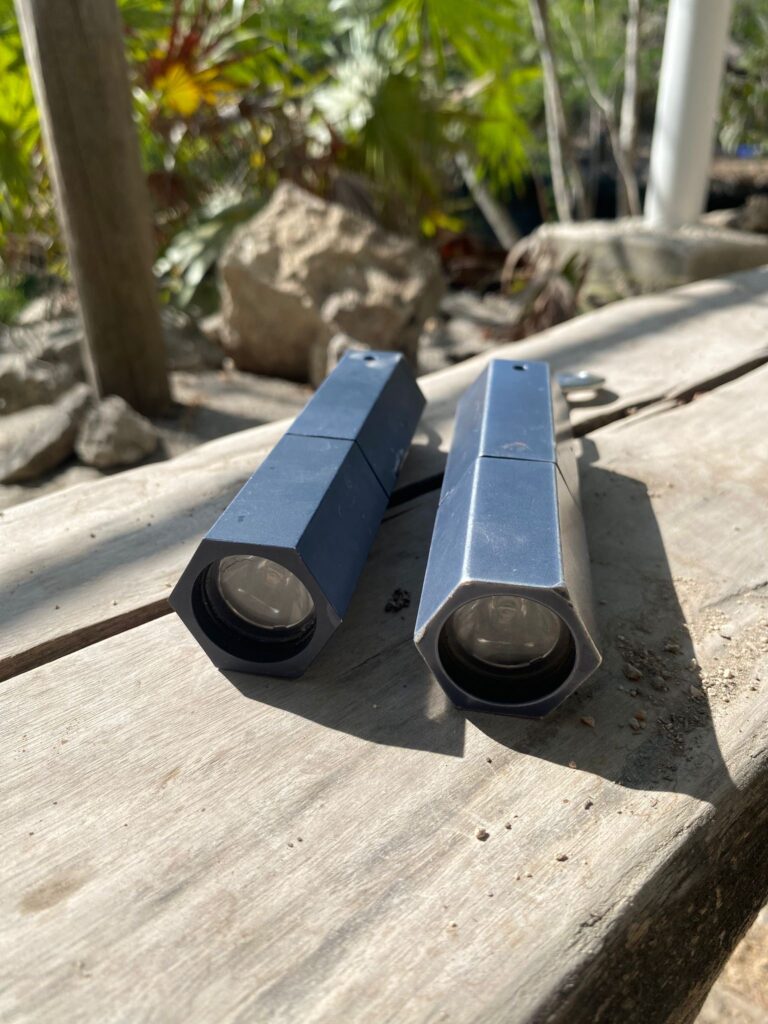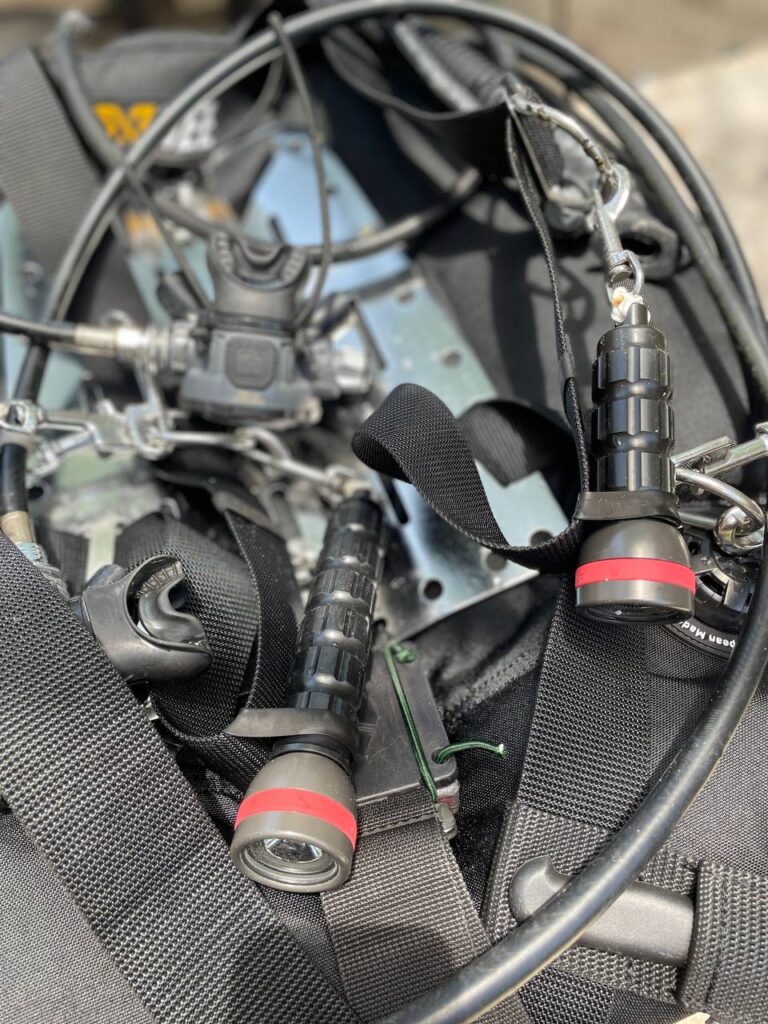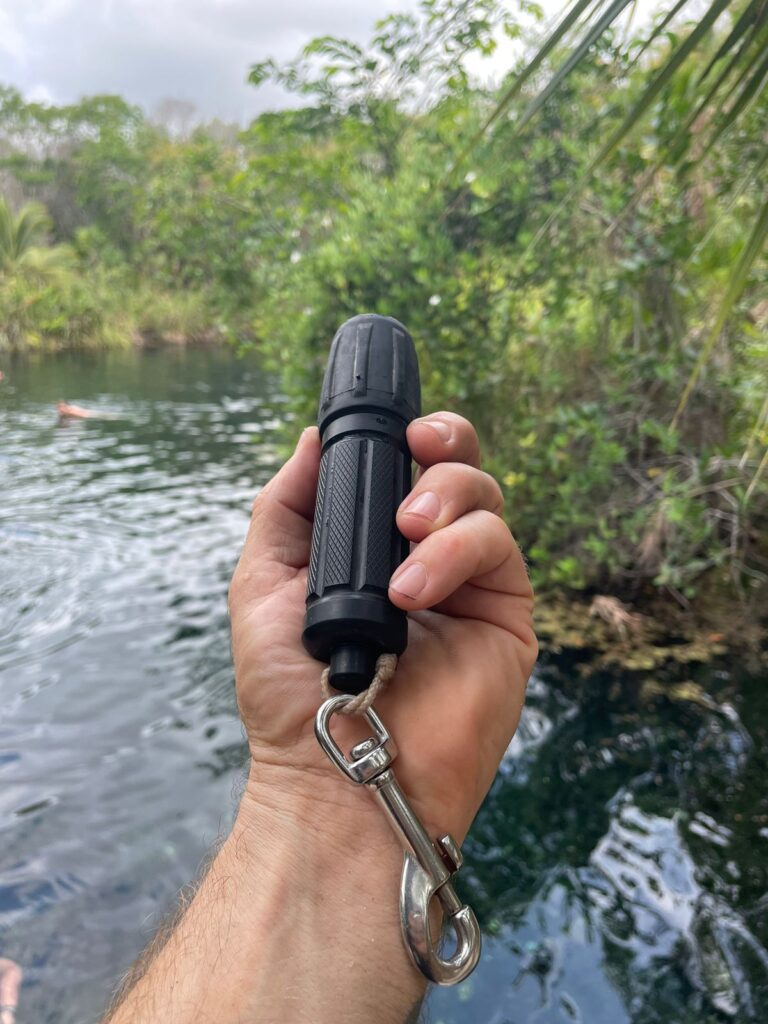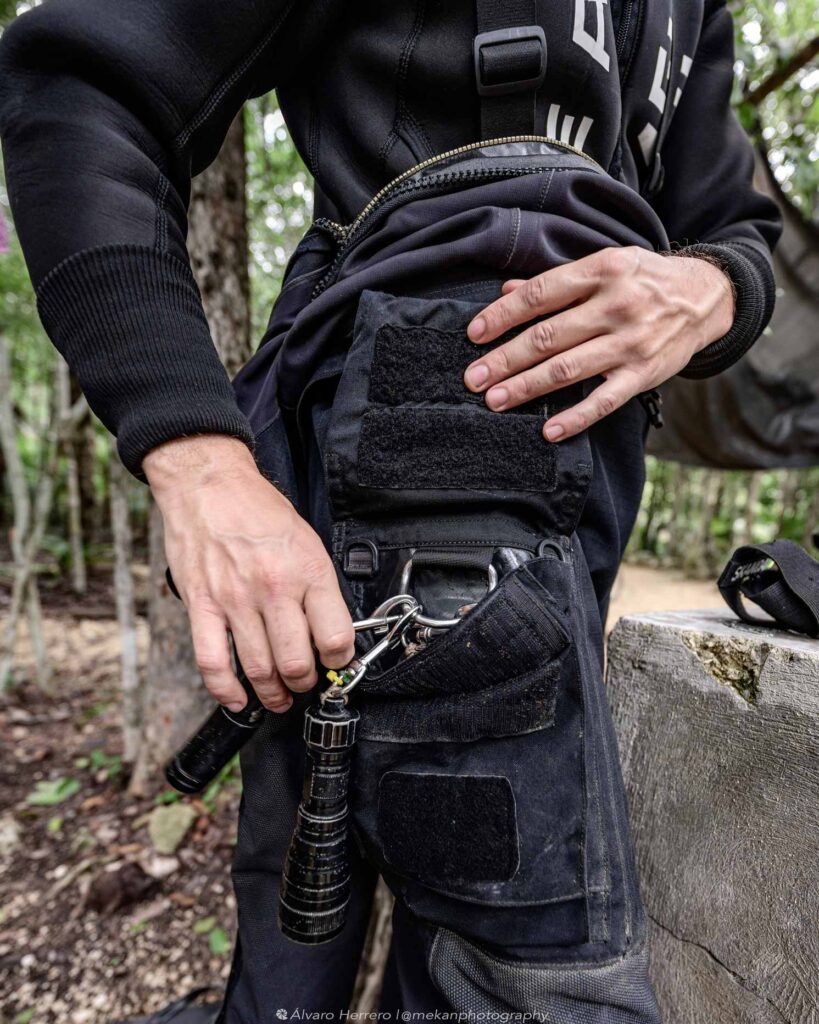Lately, I’ve unfortunately lost two of my backup lights, which led me to question: what would be the perfect replacement? This is a particularly difficult choice for me because I am a bit old-fashioned and tend to get emotionally attached to my equipment. I’ve been using the same lights for almost ten years. Not to mention, the sheer amount of gear available on the market nowadays, coupled with technological innovations, can be overwhelming.
As a cave diver, I try to use the best, most reliable equipment I can afford, and backup lights are no exception. As you know, there is no natural light in caves, so if my primary light fails, I need to be able to safely (and comfortably) exit the cave from the furthest point of penetration. I would also like to make a purchase once and not have to think about upgrading for as long as possible.
As I was researching what’s new on the market, it dawned on me: I work and dive with some of the best, most experienced cave divers, instructors, and explorers in the world. Why don’t I ask for their opinions before making my own choice? So I did, and I asked a very simple question: What do you currently use and why? Here are some of the responses I got, in no particular order:
Marc Anderes uses a very cool-looking HW backup from the German brand “Heinrichs Weikamp.”
Here are some technical details from their website:
- Operated with a 18650 rechargeable battery
- 30x130mm
- 200g
- 8°, 4W LED, 480lm at chip, 4000K
- Min. 350lm real measured light output (Ulbricht-Sphere)
- Max. depth 300m

Marc says: “They are relatively small and light, while suitable for both backmount and sidemount. And for me, this is the big one since I dive both configurations and don’t want to have multiple sets of backup lights.” His other considerations when choosing lights were a long burn time and rechargeable batteries, as he admits that it is easier for him to recharge batteries than change them. It’s less impactful on the environment too, and I’m happy to see people who care about that. Marc also prefers twist switches over buttons, so his choice works perfectly for him.
What can I say? Having Marc as my usual dive buddy, I certainly agree that his backups look quite unusual and ergonomic.
Tamara Adame switched to the Bigblue AL1300 NP a few years ago when she realized that her diving had gotten more serious and she needed to upgrade some of her gear.
Let’s take a look at some characteristics:
- Operated with a 18650 rechargeable battery
- 168g
- XML LED, 10° beam angle, 1300 Lm (lvl I). Three power level options.
- Tested to 100 meters
- 20 hours burn time on level I, 2 hours on level IV
Tamara comments on her choice: “This light is lightweight as it’s made of aluminum. It has a burn time of 5 hours on a medium setting and 20 hours on the lowest, together with a 10-degree beam angle, and shines pretty strong—it could actually be used as a primary.” She needs a reliable light to exit even from a long dive without worrying about burn time. Exploration dives, like the one she recently did in Belize, set higher requirements for the gear she uses. The lights she chose also work well mounted on a helmet when she is doing a survey.
Just like Marc, she prefers a light with a rechargeable battery, so she can always check if it’s fully charged.
She explains her choice further: “These lights fit nicely into my small drysuit pocket flaps. They also work pretty well mounted on the helmet when using a primary on the other side (for weight compensation), and I can stick one on the Goodman handle if my primary goes out, so I can still manage as normal.”
It was important for her that the lights are tested to at least 100 meters to be able to do deep diving in the near future. Another feature she likes is the push-button and battery level indicators, which I also think are brilliant.
Tamara seems to be quite happy with her choice: “Overall, I feel that I won’t have to upgrade again for a long time. Price-wise, it makes sense because they aren’t cheap,” she says.
She’s not the only one who feels this way. Alessandro Totola also chose the Bigblue AL1300 NP, saying they are “Really tough and a good size. Super powerful and bright. They have a sharp beam, which is good for communication. The only downside is that the button lights risk turning on by themselves while in your pocket or pouch.”
I guess the button vs. twist debate is quite common among divers. Historically, twist switches were considered more reliable, but with technological improvements, buttons have proven to work well and have become increasingly popular (despite the fact that they can turn on by themselves). Twist switches, if not fully turned off, can also turn on under pressure, and if turned too far, run the risk of flooding. I guess it sometimes comes down to what you feel comfortable with.

Skanda Coffield-Feith decided not to specify which brand he uses, saying: “I don’t really have a preferred brand, but I want lights that use rechargeable batteries. The newer ones that can be charged with USB, like those used in Ammonite lights, are nice. It’s nice to have ones that last 2+ hours and have decent power so they can still be used to exit without having very low visibility (more for solo diving, as in a team there should be lots of light).”
Diving in a sidemount configuration, he likes to keep his backup lights in his pouch and currently has a twist and a button-activated light in there. If he’s exploring or using a DPV, he will often use a helmet, so he also stores a backup light on that if he’s using it. He also always has a backup primary light with him in case his primary fails in or out of the water, or if there is an issue with his buddy’s light. For this, he carries a Bigblue video light. I think it’s a good idea to resort to another primary light instead of one of the backups. The only downside I see is the need to carry an extra, rather heavy piece of equipment. Skanda is another diver who prefers rechargeable batteries over standard ones.
Back in the day, the “gold standard” for tech and cave diving was a non-rechargeable battery. The reasoning was that the output decreases as the battery power decreases, so it acts as an early warning sign about battery depletion. A rechargeable battery will output 100% until it dies (battery management systems being an exception). I personally like the idea of rechargeable ones because I don’t see an issue with charging them regularly, and it creates less waste in the long run.
This being said, let’s talk about the light I still haven’t lost and currently use for my diving.
I use the Heser Backup II short.
It is a twist-activated light with non-rechargeable batteries that I find great for backmount diving.
- Largest diameter (at the lamp head): 48mm
- Diameter of the tube: 37mm
- Total length: 170mm
- Operates down to 200 meters
- Battery type: Baby C
- Burn time: 8 hours or longer, depending on the battery
“It has great focus for communication, and it’s durable and reliable. Another cool feature is the completely sealed LED unit, so it will continue to function even if flooded. On the downside, it’s a bit large. While it works well mounted on the shoulders, it doesn’t fit nicely in my drysuit pockets, where I keep all my extra equipment when diving sidemount. I would like to have a light that I can use while diving in all configurations.”
Another similar DIR-style twist light with non-rechargeable batteries that is popular among cave divers is used by Jake Bulman It is the Light Monkey 2W LED Backup.

- Operates down to 150m
- 125 lm
- 360 min burn time
- 10° angle
- 12.7 cm length with 3.4 cm head diameter
Jake says: “I’ve been using it for almost 10 years now, and they’ve been great. Durable, super light, small, and with long burn times. What they lack in is brightness, but I’ve used them to exit twice in my life, and they were sufficient. It wasn’t a well-illuminated cave by any means, but it was enough. Now there are significantly brighter lights that are also not huge, so I might replace them soon.”
I totally agree with Jake on this one since this is what I had been using for years before I managed to lose it. The only downside is the brightness, I’d say, but overall, it’s a great light.
I was most curious about which lights the legend himself, Kim Davidson uses.
His answer wasn’t a surprise: “I personally use the Light Monkey LED 2W. It’s small, light, bulletproof, and very trustworthy,” Kim said, further explaining his choice:

“I’ve had the same lights for probably 15 years, and they just work. I like simplicity, and once you’ve done a few thousand dives with your lights, they kinda become your safe companions. Due to the quality of modern primary lights, I’m less and less worried about primary light failure. I’m not going to say that good backup lights aren’t important, but I have my trusted old backup lights. They’ve never failed me, and they would get me home if my primary light failed. That’s the main reason I use the lights that I use. They might not be the most powerful lights anymore, but I’m a little bit emotionally attached to them.”
Good to know I’m not the only one who gets attached to my gear!
Kim also has a few more lights in his possession:
The first one is a classic Halcyon Scout light. “When I dive doubles, I like to use something a little bigger. It fits well on the harness, and it’s something to grip, especially if you use drysuit gloves.”
I totally see the point here, as fitting a tiny light on the harness could look funny but also be non-functional. Halcyon Scout was one of my first lights as well, but unfortunately, I managed to drown it. The original thought behind the Halcyon light construction was to avoid rechargeable batteries because their power curve declines quickly. You “should” always have three cells to build a bridge through possible failing cells. They are also twist lights—no switches that can fail and a very simple construction, which is very DIR style. Love it!
“When I dive sidemount, I kinda want to go lean and mean, and I prefer smaller lights. The absolute beast of a light is Heser—probably the best traditional DIR light on Planet Earth. The build quality is there; it’s extremely well-manufactured,” Kim continues.
It also has Kim’s name on it, which is next-level cool. Well, I don’t use a pouch for my sidemount diving, and as mentioned earlier, I don’t quite like how Heser fits into the drysuit pocket.
Kim also added: “If I had a couple hundred dollars to spend on a light today, I’d most likely get something like the Bigblue 1300 LM. It’s a very solid switch light. This could technically give you light for a long time on a lower setting.”
He mentioned that he also likes its tight beam, which is good for communication. And while the switch could be a failure point, it’s 2024, and he thinks switches are pretty good now. Even though he’s been using non-rechargeable batteries for years, he now admits that he’s not too worried about rechargeable batteries anymore. “An advantage is it’s less likely to turn on by itself, unless you press the button. Another thing is it’s a one-handed operation; it’s very easy to turn on if it’s on your helmet, for instance,” Kim shares his thoughts. I personally have never used helmets, so I can’t speak for this, but it seems to be a very logical and valid point.
It was super interesting for me to get all these opinions from my colleagues, as well as to interview them all. As of now, I think I know what my next purchase will be. I hope this will also be helpful for those of you who are in the market for lights. With that being said, may your primary light never fail on you in the cave, my friends!
